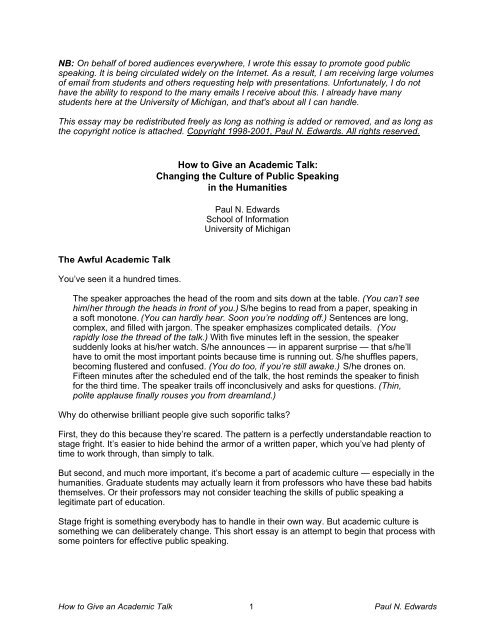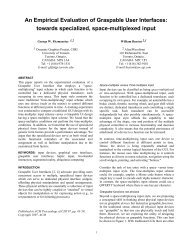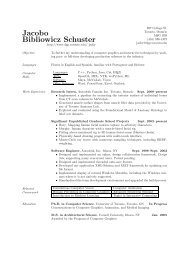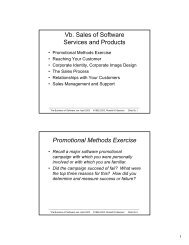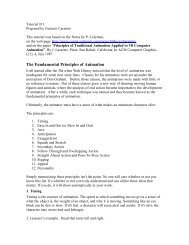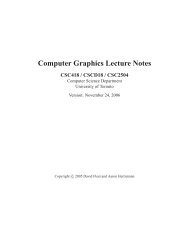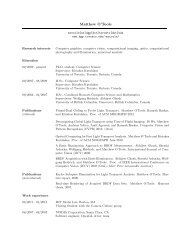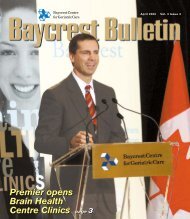How to Give an Academic Talk: Changing the Culture of Public ...
How to Give an Academic Talk: Changing the Culture of Public ...
How to Give an Academic Talk: Changing the Culture of Public ...
Create successful ePaper yourself
Turn your PDF publications into a flip-book with our unique Google optimized e-Paper software.
NB: On behalf <strong>of</strong> bored audiences everywhere, I wrote this essay <strong>to</strong> promote good public<br />
speaking. It is being circulated widely on <strong>the</strong> Internet. As a result, I am receiving large volumes<br />
<strong>of</strong> email from students <strong>an</strong>d o<strong>the</strong>rs requesting help with presentations. Unfortunately, I do not<br />
have <strong>the</strong> ability <strong>to</strong> respond <strong>to</strong> <strong>the</strong> m<strong>an</strong>y emails I receive about this. I already have m<strong>an</strong>y<br />
students here at <strong>the</strong> University <strong>of</strong> Michig<strong>an</strong>, <strong>an</strong>d that's about all I c<strong>an</strong> h<strong>an</strong>dle.<br />
This essay may be redistributed freely as long as nothing is added or removed, <strong>an</strong>d as long as<br />
<strong>the</strong> copyright notice is attached. Copyright 1998-2001, Paul N. Edwards. All rights reserved.<br />
The Awful <strong>Academic</strong> <strong>Talk</strong><br />
You’ve seen it a hundred times.<br />
<strong>How</strong> <strong>to</strong> <strong>Give</strong> <strong>an</strong> <strong>Academic</strong> <strong>Talk</strong>:<br />
Ch<strong>an</strong>ging <strong>the</strong> <strong>Culture</strong> <strong>of</strong> <strong>Public</strong> Speaking<br />
in <strong>the</strong> Hum<strong>an</strong>ities<br />
Paul N. Edwards<br />
School <strong>of</strong> Information<br />
University <strong>of</strong> Michig<strong>an</strong><br />
The speaker approaches <strong>the</strong> head <strong>of</strong> <strong>the</strong> room <strong>an</strong>d sits down at <strong>the</strong> table. (You c<strong>an</strong>’t see<br />
him/her through <strong>the</strong> heads in front <strong>of</strong> you.) S/he begins <strong>to</strong> read from a paper, speaking in<br />
a s<strong>of</strong>t mono<strong>to</strong>ne. (You c<strong>an</strong> hardly hear. Soon you’re nodding <strong>of</strong>f.) Sentences are long,<br />
complex, <strong>an</strong>d filled with jargon. The speaker emphasizes complicated details. (You<br />
rapidly lose <strong>the</strong> thread <strong>of</strong> <strong>the</strong> talk.) With five minutes left in <strong>the</strong> session, <strong>the</strong> speaker<br />
suddenly looks at his/her watch. S/he <strong>an</strong>nounces — in apparent surprise — that s/he’ll<br />
have <strong>to</strong> omit <strong>the</strong> most import<strong>an</strong>t points because time is running out. S/he shuffles papers,<br />
becoming flustered <strong>an</strong>d confused. (You do <strong>to</strong>o, if you’re still awake.) S/he drones on.<br />
Fifteen minutes after <strong>the</strong> scheduled end <strong>of</strong> <strong>the</strong> talk, <strong>the</strong> host reminds <strong>the</strong> speaker <strong>to</strong> finish<br />
for <strong>the</strong> third time. The speaker trails <strong>of</strong>f inconclusively <strong>an</strong>d asks for questions. (Thin,<br />
polite applause finally rouses you from dreaml<strong>an</strong>d.)<br />
Why do o<strong>the</strong>rwise brilli<strong>an</strong>t people give such soporific talks?<br />
First, <strong>the</strong>y do this because <strong>the</strong>y’re scared. The pattern is a perfectly underst<strong>an</strong>dable reaction <strong>to</strong><br />
stage fright. It’s easier <strong>to</strong> hide behind <strong>the</strong> armor <strong>of</strong> a written paper, which you’ve had plenty <strong>of</strong><br />
time <strong>to</strong> work through, th<strong>an</strong> simply <strong>to</strong> talk.<br />
But second, <strong>an</strong>d much more import<strong>an</strong>t, it’s become a part <strong>of</strong> academic culture — especially in <strong>the</strong><br />
hum<strong>an</strong>ities. Graduate students may actually learn it from pr<strong>of</strong>essors who have <strong>the</strong>se bad habits<br />
<strong>the</strong>mselves. Or <strong>the</strong>ir pr<strong>of</strong>essors may not consider teaching <strong>the</strong> skills <strong>of</strong> public speaking a<br />
legitimate part <strong>of</strong> education.<br />
Stage fright is something everybody has <strong>to</strong> h<strong>an</strong>dle in <strong>the</strong>ir own way. But academic culture is<br />
something we c<strong>an</strong> deliberately ch<strong>an</strong>ge. This short essay is <strong>an</strong> attempt <strong>to</strong> begin that process with<br />
some pointers for effective public speaking.<br />
<strong>How</strong> <strong>to</strong> <strong>Give</strong> <strong>an</strong> <strong>Academic</strong> <strong>Talk</strong> 1<br />
Paul N. Edwards
Principles <strong>of</strong> Effective <strong>Talk</strong>s<br />
Any effective talk must do three things:<br />
(1) communicate your arguments <strong>an</strong>d evidence,<br />
(2) persuade your audience that <strong>the</strong>y are true, <strong>an</strong>d<br />
(3) be interesting <strong>an</strong>d entertaining.<br />
In our obsession with persuasive argumentation, academics sometimes forget about <strong>the</strong> third<br />
item on this list. Sometimes we think it follows au<strong>to</strong>matically from <strong>the</strong> first two. (It doesn’t.)<br />
Sometimes we even sc<strong>of</strong>f at <strong>the</strong> goal itself. Perversely, we seem <strong>to</strong> believe that if a talk is<br />
entertaining, it’s probably not very deep.<br />
These attitudes are seriously mistaken. It is impossible <strong>to</strong> communicate <strong>an</strong>d persuade<br />
effectively without entertaining as well. Keeping your audience interested <strong>an</strong>d involved —<br />
entertaining <strong>the</strong>m — is essential because in order <strong>to</strong> communicate your work <strong>an</strong>d its value, you<br />
need <strong>the</strong>ir full attention.<br />
Listening is hard work. Especially at conferences, where audiences listen <strong>to</strong> m<strong>an</strong>y talks over<br />
m<strong>an</strong>y hours, people need <strong>the</strong> speaker’s help <strong>to</strong> maintain <strong>the</strong>ir focus. This is <strong>the</strong> true me<strong>an</strong>ing <strong>an</strong>d<br />
import<strong>an</strong>ce <strong>of</strong> “entertainment.” In <strong>an</strong> academic talk, entertainment isn’t about making your<br />
audience laugh or distracting <strong>the</strong>m from <strong>the</strong>ir troubles, but simply about keeping <strong>the</strong>m focused on<br />
<strong>an</strong>d interested in what you have <strong>to</strong> say.<br />
<strong>How</strong> <strong>to</strong> <strong>Give</strong> a Great <strong>Talk</strong>: Some Rules <strong>of</strong> Thumb<br />
No rule applies always <strong>an</strong>d everywhere. But <strong>the</strong> following principles work almost all <strong>the</strong> time. Try<br />
<strong>the</strong>m!<br />
USUALLY BETTER USUALLY WORSE<br />
• <strong>Talk</strong> • Read<br />
• St<strong>an</strong>d • Sit<br />
• Move • St<strong>an</strong>d still<br />
• Vary <strong>the</strong> pitch <strong>of</strong> your voice • Speak in a mono<strong>to</strong>ne<br />
• Speak loudly <strong>an</strong>d clearly,<br />
<strong>to</strong>ward <strong>the</strong> audience<br />
• Mumble, facing downward<br />
• Make eye contact with <strong>the</strong><br />
audience<br />
• Stare at <strong>the</strong> podium<br />
• Focus on main arguments • Get lost in details<br />
• Use visual aids: outlines,<br />
• Have no visual aids<br />
pictures, graphs<br />
• Finish your talk within your<br />
time limit. Corollary: rehearse<br />
your talk<br />
• Summarize your main<br />
arguments at <strong>the</strong> beginning <strong>an</strong>d<br />
end<br />
• Notice your audience <strong>an</strong>d<br />
respond <strong>to</strong> its needs<br />
• Emulate excellent speakers<br />
• Run overtime. Don’t practice.<br />
• Fail <strong>to</strong> provide a conclusion<br />
• Ignore audience behavior<br />
<strong>How</strong> <strong>to</strong> <strong>Give</strong> <strong>an</strong> <strong>Academic</strong> <strong>Talk</strong> 2<br />
Paul N. Edwards
This list really says it all. But a little discussion may help make clear why <strong>the</strong>se principles are so<br />
import<strong>an</strong>t.<br />
1) <strong>Talk</strong> ra<strong>the</strong>r th<strong>an</strong> read. It’s easier <strong>to</strong> listen <strong>to</strong> <strong>an</strong>d underst<strong>an</strong>d, <strong>an</strong>d it allows you <strong>to</strong> make<br />
genuine contact with your audience. Fur<strong>the</strong>rmore, it ultimately helps you <strong>to</strong> think more<br />
clearly, by forcing you <strong>to</strong> communicate your points in ordinary terms.<br />
2) St<strong>an</strong>d up unless you’re literally forced <strong>to</strong> sit. People c<strong>an</strong> see you better. St<strong>an</strong>ding also puts<br />
you in a domin<strong>an</strong>t position. This may sound politically incorrect, but it’s not. Remember,<br />
you’re <strong>the</strong> focus. The audience w<strong>an</strong>ts you <strong>to</strong> be in charge. Listeners need your help <strong>to</strong><br />
maintain <strong>the</strong>ir attention.<br />
3) Move around, ra<strong>the</strong>r th<strong>an</strong> st<strong>an</strong>ding still. It’s easier <strong>to</strong> keep focused on someone who’s<br />
moving th<strong>an</strong> on a motionless talking head. (H<strong>an</strong>d gestures are good, <strong>to</strong>o.)<br />
It’s possible <strong>to</strong> overdo this one, though. Simply walking back <strong>an</strong>d forth from one side <strong>of</strong><br />
<strong>the</strong> room <strong>to</strong> <strong>the</strong> o<strong>the</strong>r every three or four minutes is probably enough. Gesturing <strong>to</strong>o much<br />
will create distraction.<br />
4) Vary <strong>the</strong> pitch <strong>of</strong> your voice. Mono<strong>to</strong>nes are sleep-inducing. M<strong>an</strong>y people don’t realize <strong>the</strong>y<br />
do this. Get a trusted friend or colleague <strong>to</strong> listen <strong>to</strong> your delivery <strong>an</strong>d give you honest<br />
feedback. (This is <strong>an</strong> import<strong>an</strong>t principle in itself!) Even better, tape or videotape yourself<br />
<strong>an</strong>d check out how you sound.<br />
5) Speak loudly <strong>an</strong>d clearly, facing <strong>the</strong> audience. Be careful, especially when using visual<br />
aids, that you continue <strong>to</strong> face <strong>the</strong> audience when you speak.<br />
An import<strong>an</strong>t element <strong>of</strong> vocal technique is <strong>to</strong> focus on <strong>the</strong> bot<strong>to</strong>m (<strong>the</strong> deepest pitch) <strong>of</strong><br />
your vocal r<strong>an</strong>ge, which is its loudest <strong>an</strong>d most authoritative <strong>to</strong>ne. (This c<strong>an</strong> be especially<br />
import<strong>an</strong>t for women.) Speak from <strong>the</strong> gut, not <strong>the</strong> throat. Brea<strong>the</strong> deeply — it’s<br />
necessary for volume, <strong>an</strong>d will also help you keep your mind clear.<br />
Tip: here are two effective vocal “special effects.” First, when you come <strong>to</strong> a key<br />
phrase that you w<strong>an</strong>t people <strong>to</strong> remember, repeat it. Second, pause for a few seconds at<br />
several points in your talk; this breaks <strong>the</strong> mono<strong>to</strong>ny <strong>of</strong> a continuous flow <strong>of</strong> speech. It<br />
also gives you a ch<strong>an</strong>ce <strong>to</strong> sip some water.<br />
6) Make eye contact with <strong>the</strong> audience. If this is <strong>an</strong>xiety-inducing, at least pretend <strong>to</strong> do so<br />
by casting your gaze <strong>to</strong>ward <strong>the</strong> back <strong>an</strong>d sides <strong>of</strong> <strong>the</strong> room.<br />
Be careful not <strong>to</strong> ignore one side <strong>of</strong> <strong>the</strong> audience. M<strong>an</strong>y speakers “side” unconsciously,<br />
looking always <strong>to</strong> <strong>the</strong> left or <strong>to</strong> <strong>the</strong> right half, or only <strong>to</strong> <strong>the</strong> front or <strong>the</strong> back, <strong>of</strong> <strong>the</strong> room.<br />
7) Focus on main arguments. Especially in a conference situation, where talks are short <strong>an</strong>d<br />
yours is one <strong>of</strong> m<strong>an</strong>y, your audience is not going <strong>to</strong> remember <strong>the</strong> details <strong>of</strong> your<br />
evidence. In such a situation, less is more. <strong>Give</strong> <strong>the</strong>m short, striking “punch lines” that<br />
<strong>the</strong>y’ll remember. They c<strong>an</strong> always read your written work later, but if you don’t get <strong>the</strong>m<br />
interested <strong>an</strong>d show <strong>the</strong>m why it’s import<strong>an</strong>t, <strong>the</strong>y won’t w<strong>an</strong>t <strong>to</strong>.<br />
8) Use visual aids. This is one <strong>of</strong> <strong>the</strong> most import<strong>an</strong>t principles <strong>of</strong> all. At a minimum, have <strong>an</strong><br />
outline <strong>of</strong> your talk. Some people seem <strong>to</strong> think <strong>the</strong>y’re giving everything away by<br />
showing people what <strong>the</strong>y’re going <strong>to</strong> say before <strong>the</strong>y’ve said it. But <strong>the</strong> effect <strong>of</strong> a good<br />
<strong>How</strong> <strong>to</strong> <strong>Give</strong> <strong>an</strong> <strong>Academic</strong> <strong>Talk</strong> 3<br />
Paul N. Edwards
talk outline is exactly <strong>the</strong> opposite: it makes your audience w<strong>an</strong>t <strong>to</strong> hear <strong>the</strong> details. At <strong>the</strong><br />
same time, it helps <strong>the</strong>m underst<strong>an</strong>d <strong>the</strong> structure <strong>of</strong> your thinking.<br />
<strong>Talk</strong> outlines should be extremely concise <strong>an</strong>d visually uncluttered. 7-10 lines <strong>of</strong> text per<br />
slide is plenty.<br />
Pictures, graphs, <strong>an</strong>d o<strong>the</strong>r images are especially helpful. People are visual creatures.<br />
The old adage that a picture is worth a thous<strong>an</strong>d words is especially apropos in <strong>the</strong><br />
context <strong>of</strong> a talk.<br />
One very import<strong>an</strong>t principle <strong>of</strong> slide presentations: always choose white or light-colored<br />
backgrounds. To see dark slides, you’ll have <strong>to</strong> turn <strong>of</strong>f <strong>the</strong> lights. This will make it hard<br />
for you <strong>to</strong> see your notes, <strong>an</strong>d will also tend <strong>to</strong> put your audience <strong>to</strong> sleep. Really. If at all<br />
possible, do NOT turn <strong>of</strong>f room lights or close window shades! Light-colored slides c<strong>an</strong><br />
usually be read with lights on.<br />
Don’t talk <strong>to</strong> <strong>the</strong> screen. If you do, not only will <strong>the</strong> audience be looking at your back, but<br />
also <strong>the</strong>y’ll be unable <strong>to</strong> hear you. Have a paper version <strong>of</strong> your outline in front <strong>of</strong> you;<br />
speak from that, ra<strong>the</strong>r th<strong>an</strong> from <strong>the</strong> one on <strong>the</strong> screen. This takes practice.<br />
About Powerpoint:<br />
Micros<strong>of</strong>t Powerpoint — now st<strong>an</strong>dard issue in m<strong>an</strong>y presentation settings — c<strong>an</strong> be a<br />
great <strong>to</strong>ol, not least because its default presentation formats encourage brevity.<br />
But beware: Powerpoint’s fades, tr<strong>an</strong>sitions, backgrounds, sound effects, <strong>an</strong>d so on c<strong>an</strong><br />
be a real pitfall. Preparing glitzy presentations c<strong>an</strong> be a serious time sink for you. Worse,<br />
<strong>the</strong>y c<strong>an</strong> give your audience <strong>the</strong> impression that you care more about surface th<strong>an</strong><br />
subst<strong>an</strong>ce.<br />
My recommendation: choose simple, light-colored backgrounds with dark type, <strong>an</strong>d limit<br />
<strong>the</strong> use <strong>of</strong> special effects.<br />
9) Finish your talk within <strong>the</strong> time limit. Not <strong>to</strong> do so is disrespectful <strong>of</strong> your audience, not<br />
<strong>to</strong> mention bad strategy. Never go on longer th<strong>an</strong> 45 minutes, which is most people’s<br />
maximum attention sp<strong>an</strong>. If you exceed this limit, you’ll lose <strong>the</strong>m at <strong>the</strong> crucial point,<br />
namely your conclusion.<br />
Fur<strong>the</strong>rmore, in conference settings, exceeding your time limit c<strong>an</strong> be incredibly rude,<br />
since it cuts in<strong>to</strong> o<strong>the</strong>r speakers’ allotted time <strong>an</strong>d/or <strong>the</strong> discussion period. You c<strong>an</strong> make<br />
real enemies by insisting on continuing after your time is up.<br />
The only way <strong>to</strong> be certain you c<strong>an</strong> keep within your limits is <strong>to</strong> rehearse your talk. After<br />
lots <strong>of</strong> experience, some people c<strong>an</strong> gauge talk times accurately without this. But nothing<br />
is more embarrassing — for both you <strong>an</strong>d your audience — th<strong>an</strong> getting only halfway<br />
through before hitting <strong>the</strong> time limit.<br />
Tip: If you use Powerpoint or some o<strong>the</strong>r presentation system, you c<strong>an</strong> develop a good<br />
sense <strong>of</strong> timing by always using <strong>the</strong> same slide format. After you’ve given a few talks<br />
with <strong>the</strong> same format, you’ll know about how long it takes you <strong>to</strong> talk through each slide,<br />
<strong>an</strong>d you c<strong>an</strong> gauge <strong>the</strong> length <strong>of</strong> your talk this way (at least roughly).<br />
<strong>How</strong> <strong>to</strong> <strong>Give</strong> <strong>an</strong> <strong>Academic</strong> <strong>Talk</strong> 4<br />
Paul N. Edwards
10) Summarize your talk at <strong>the</strong> beginning <strong>an</strong>d again at <strong>the</strong> end. “Tell ‘em what you’re<br />
gonna tell ‘em; tell ‘em; <strong>an</strong>d tell ‘em what you <strong>to</strong>ld ‘em”: this <strong>an</strong>cient principle still holds.<br />
Following this rule helps your audience get your main points. Even more import<strong>an</strong>t, it helps<br />
<strong>the</strong>m remember what you said, which is, after all, what you’re <strong>the</strong>re for.<br />
11) Notice your audience <strong>an</strong>d respond <strong>to</strong> its needs. If people seem <strong>to</strong> be falling asleep or<br />
getting restless or distracted, <strong>the</strong> problem may not be you. Is <strong>the</strong> room <strong>to</strong>o hot or cold?<br />
Too dark? (This is especially import<strong>an</strong>t.) C<strong>an</strong> people see you? Is <strong>the</strong> microphone on? Is<br />
something outside <strong>the</strong> room distracting people? Don’t hesitate <strong>to</strong> s<strong>to</strong>p talking in order <strong>to</strong><br />
solve <strong>the</strong>se problems.<br />
Alternatively, you may have gone on <strong>to</strong>o long, or you may need <strong>to</strong> speak louder.<br />
Whatever <strong>the</strong> case, notice what’s happening <strong>an</strong>d use it as feedback. If you c<strong>an</strong>’t figure<br />
out why your audience is responding poorly, ask somebody later <strong>an</strong>d fix <strong>the</strong> problem next<br />
time.<br />
If you’re not sure whe<strong>the</strong>r people c<strong>an</strong> see or hear, ask someone in <strong>the</strong> back row directly.<br />
(This is also a good technique for setting up initial communication with your audience. It<br />
makes listeners feel included, <strong>an</strong>d puts you in <strong>to</strong>uch with <strong>the</strong>m as hum<strong>an</strong> beings.)<br />
Tip: NEVER let someone else take control <strong>of</strong> room conditions. M<strong>an</strong>y audiences — thinking<br />
<strong>the</strong>y’re being helpful — react <strong>to</strong> slide or computer projec<strong>to</strong>rs by jumping up <strong>to</strong> turn <strong>of</strong>f<br />
lights <strong>an</strong>d close window shades. Unless this is truly necessary, avoid it at all costs,<br />
especially at conferences, which <strong>of</strong>ten take place in exceedingly dim rooms. Taking<br />
charge <strong>of</strong> <strong>the</strong> talk environment is part <strong>of</strong> your job as a speaker.<br />
12) Emulate excellent speakers. Perhaps <strong>the</strong> best way <strong>to</strong> become <strong>an</strong> excellent speaker<br />
yourself is <strong>to</strong> watch really good, experienced speakers <strong>an</strong>d model your talks on <strong>the</strong>irs.<br />
Notice not just what <strong>the</strong>y say, but what <strong>the</strong>y do.<br />
<strong>How</strong> <strong>to</strong> <strong>Give</strong> <strong>an</strong> <strong>Academic</strong> <strong>Talk</strong> 5<br />
Paul N. Edwards


